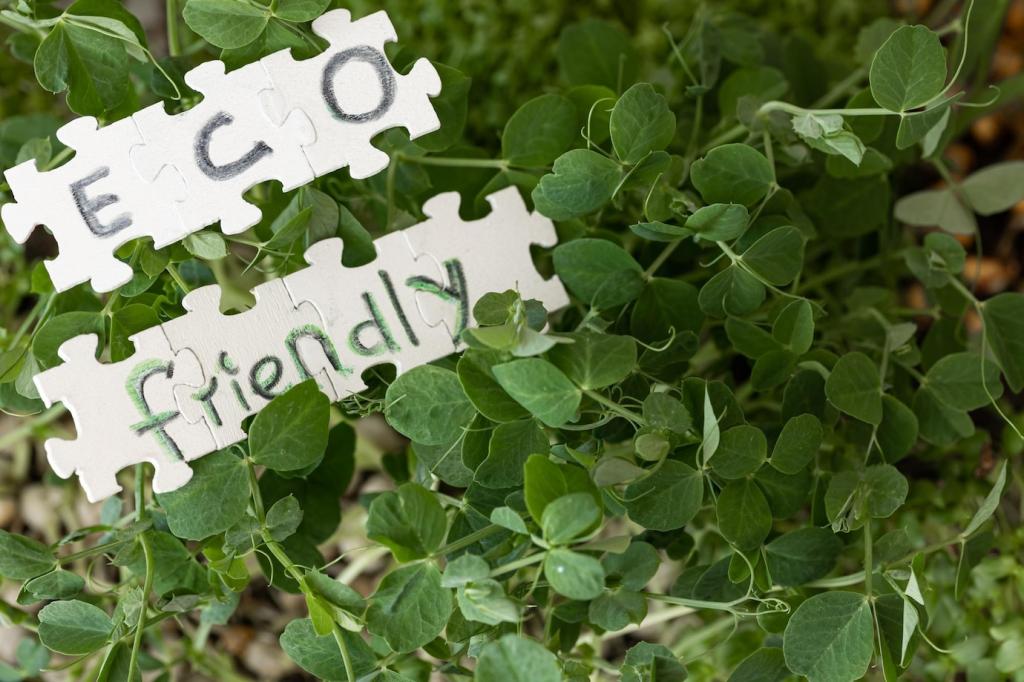Successful Eco-Living Communities: Real Places, Real Change
What Success Looks Like in Eco-Living Communities
A Shared Purpose You Can Feel
Communities that thrive start with a living purpose that residents actually reference in daily choices. When a shared vision informs meetings, budgets, and garden chores, sustainability stops being a slogan and starts steering every small decision toward durable, joyful results.
Right-Size Structures, Real Accountability
Too much bureaucracy drains energy; too little invites confusion. Successful eco-living groups balance clear roles with flexible teams so people can act, learn, and adjust fast. This combination keeps momentum high while ensuring decisions support long-term ecological goals and social wellbeing.
An Anecdote from a Shared Path
One community welcomed new families by gifting them starter seed kits and a tour of rainwater systems. The children immediately asked how to care for pollinators. That small moment signaled a culture where curiosity leads, and sustainability education begins on day one.
Circles handle clear domains, proposals evolve through feedback rounds, and consent decisions keep the focus on “good enough for now, safe enough to try.” People feel heard, meetings end on time, and experiments move forward without waiting for mythical perfection.
Governance and Participation That Keep Communities Thriving
Restorative circles and skilled facilitation transform disagreements into learning. When neighbors process tensions with care, relationships strengthen. Over time, the community builds muscles for honest conversations, creative compromise, and decisions that leave dignity intact for everyone involved.
Governance and Participation That Keep Communities Thriving
Passive Comfort, All Year
High insulation, airtight envelopes, and heat recovery ventilation deliver steady comfort with minimal energy. Residents often remark on their first quiet winter without drafts, realizing sustainability can feel luxurious when the building itself does most of the climate work.
Shared Amenities, Smaller Footprints
Tool libraries, guest rooms, and makerspaces cut material consumption by replacing private duplication with thoughtful sharing. A family can host relatives without owning a rarely used spare room, while neighbors borrow sanders, sewing machines, and ladders instead of each buying new.
Nature as Co-Designer
Edible landscapes, rain gardens, and native plant corridors invite birds, pollinators, and people to flourish together. Water-sensitive pathways and permeable surfaces reduce flooding while creating playful routes for children and gentle edges for evening walks and impromptu conversations.

Energy Cooperatives with Shared Benefits
Solar rooftops and microgrids managed by residents can stabilize costs and accelerate paybacks. When neighbors co-own infrastructure, they celebrate sunny days together, reinvest savings in efficiency upgrades, and gain a real stake in the systems that keep lights on.
Food Loops You Can Taste
Community-supported agriculture, orchard guilds, and composting close the loop from kitchen to soil. Weekly harvest tables become social hubs where recipes, seeds, and stories trade hands, turning sustainability into something you can smell, sauté, and share around long wooden benches.
Measuring What Matters: Impact You Can Trust
Communities often report ecological footprints lower than national averages while also measuring positive contributions—like trees planted, habitats restored, and neighbors trained in energy literacy. This balanced view highlights both reduced harm and the good created together.


Measuring What Matters: Impact You Can Trust
Simple, public dashboards show energy use, water savings, and compost volumes in real time. Colorful graphics on a common wall spark conversations, friendly challenges, and collective problem-solving when trends drift off target. Transparency strengthens trust and keeps momentum alive.
Rituals That Renew Commitment
Seasonal potlucks, solstice walks, and candlelit thank-you circles weave meaning into ordinary weeks. These moments remind everyone why they chose communal, low-impact living—and offer a gentle space to welcome newcomers into shared values and simple, nourishing traditions.
Learning Across Generations
Elders teach pruning and seed saving; teens teach coding dashboards and drone mapping. The exchange keeps knowledge fresh and relevant, and it ensures the future of the community carries both wisdom and innovation forward with confidence and humility.
A Story Bank Worth Sharing
Residents archive short reflections—first harvests, storm preparedness wins, and funny mishaps with compost tumblers. Over time, the story bank becomes a practical guide and a living memory. Share your favorite eco-living story in the comments and help grow this library.

From Inspiration to Action: Join, Support, or Start
Schedule tours or volunteer days and arrive curious about governance, finances, and maintenance routines. Ask residents what surprised them most after moving in. Tell us which community you would love to visit next, and why it speaks to your values.
